| Republic of Korea 대한민국 Timeline: Cherry, Plum, and Chrysanthemum
OTL equivalent: North Korea, South Korea, and Yanbian Korean Autonomous Prefecture | ||||||
|---|---|---|---|---|---|---|
|
||||||
| Motto: 九道一國 (Classical Korean) ("Nine different provinces make a unified nation") |
||||||
| Anthem: Aegukga |
||||||
| Location of Korea
|
||||||
| Capital | Seoul | |||||
| Other cities | Pyongyang, Busan | |||||
| Official languages | Korean | |||||
| Ethnic groups | Korean; Japanese; Russian; Chinese | |||||
| Religion | Irreligion; Buddhism; Christianity; Islam | |||||
| Demonym | Korean | |||||
| Government | Unitary state; parliamentary republic | |||||
| - | President | |||||
| - | Prime Minister | |||||
| Legislature | National Congress of Korea | |||||
| Establishment | ||||||
| - | Founding of the Republic | March 12, 1921 | ||||
| Area | ||||||
| - | Total | 266,664 km2 102,960 sq mi |
||||
| Population | ||||||
| - | estimate | 89,821,203 | ||||
| Currency | Won (₩) (KRW) |
|||||
| Time zone | KST (UTC+8:30) | |||||
| Drives on the | Right | |||||
| Internet TLD | .kr, .한국 | |||||
| Calling code | +82 | |||||
Korea (Korean: 한국 Hanguk), officially the Republic of Korea (Korean: 대한민국 Daehan Minguk), is a sovereign state in the Korean Peninsula. The name "Korea" is derived from "Goryeo", a name of the dynasty which ruled the country in the Middle Ages. Its neighbors are China to the west, Manchuria to the north, the Soviet Union to the northeast, Japan to the east, and the East China Sea to the south.
Korea lies in the north temperate zone with predominantly mountainous terrain. It covers a total area of 266,664 sq km and has a population of almost 90 million. The capital and largest city is Seoul, with a population of 10,521,782.
Climate[]
The climate of Korea differs dramatically from north to south. The southern regions experience a relatively warm and wet climate similar to that of Japan, affected by warm ocean waters including the East Korea Warm Current. The northern regions experience a colder and to some extent more inland climate, in common with Manchuria. For example, the annual precipitation of the Yalu River Valley (600 mm (24 in)) is less than one-half of that on the south coast (1500 mm (59 in)). Likewise, there is a 20° C (68° F) difference in January temperature between the peninsula's southern and northern tips.
The entire peninsula, however, is affected by similar general patterns, including the East Asian monsoon in midsummer and the frequent incidence of typhoons in autumn. The majority of rainfall takes place during the summer months, with nearly one-half during the monsoon alone. Winters are cold, with January temperatures typically below freezing outside of Jeju Island. Winter precipitation is minimal, with little snow accumulation outside of mountainous areas.
Politics and government[]

The National Congress Building in Seoul
According to the 1934 Constitution of the Republic of Korea, Korea is a sovereign and independent country that governed under the principle of National Democracy.
The National Congress of Korea (국민대표대회 Gukmin Daepyo Daehoe) is the highest state organ of Korea. Its members are elected every four years by indirect elections. The election, however, is only participated in by parties that are recognized as legal, with the Korean Nationalist Party (대한국민당 Daehan Gukmindang) as its leading party. The Congress elects the Legislative Council of Korea (립법원 Ribbeop-won) from among its members every two years to exercise the legislative power and to act on behalf of the National Congress if the latter is not in session.
The President of the Republic of Korea (총재 Chongjae) is elected by the National Congress from among its members every four years. The President is the head of state of the Republic, and the nominal commander-in-chief of the armed forces. The President of the Republic has the power to advise the Council of the Ministers in the matters concerning executive, defense and financial affairs of Korea.

Seokjojeon Hall, the seat of the government of Korea
The Council of Ministers of Korea (각료회의 Gakryo Hoeui) serves as the highest administrative body of Korea and headed by the Chairman of the Council who bearing the title of Prime Minister (총리 Chongri) and assisted by three Vice-Chairmen of the Council, who bore the title of Vice-Prime Ministers (부총리 Bu-Chongri). The composition of the Council of Ministers is nominated by a formateur committee called the Committee of Three (삼인관 Sam'in-gwan) which is consisted by three members of the National Congress that appointed by the President prior being approved by the two-thirds majority of the Congress.
The State Council of Korea (국무원 Gukmu-won) is the advisory body for the National Congress and National Government. Its members are elected by the prefectural councils and by the corporate and special interest groups every four years. The State Council acts as a supervisor of powers and duties of National Congress and represents the political parties and mass organizations that allied with or loyal to the Korean Nationalist Party.

The Supreme Court of Korea in Jongno, Seoul
The National Court of Korea (국민재판소 Gukmin Jaepanso) serves as the country's supreme judicature in charge of judicial matters and supervision and administration of lower courts. All of the judges of the Court are appointed by the National Congress of Korea from the candidates that have been nominated by the President of the Republic. All citizens of Korea are subjected to Korean law and under the authority of the National Court. The National Procuratorate of Korea (국민검찰소 Gukmin Geomchalso) charged with both the investigation and prosecution of crime at the national level and supervised the procuratorates in every level below.
History[]
Goryeo Dynasty (918–1392)[]
Goryeo under Mongol rule (1270–1351)[]
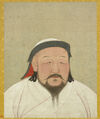
Kublai Khan (1215–1294)
Starting from 1231, the Mongol Empire, led by Kublai Khan, conducted several invasions against Korea under Goryeo. Following the invasions, the Mongols seized the northern portions of the Peninsula and integrated them into their empire as Ssangseong Prefectures and Dongnyeong Prefectures. In March 1258, Kim Jun assassinated Goryeo military commander Choe Ui, effectively ending the Choe military dictatorship of Korea; following this, scholars who had advocated on peace with Mongolia rose to power. A peace treaty was signed which included a provision requiring Korea to accept Mongol suzerainty.
Goryeo became a "completely integrated client kingdom" from 1270, but its formal protocol was that of a subordinate principality. The Mongol Empire encouraged intermarriage between Koreans and Mongols once the vassaldom was created. Goryeo kings were married to Mongol Borjigid princesses beginning with King Chungnyeol (r. 1274-1308), and Goryeo royals were raised and educated in the Yuan court. While the Goryeo court continued to exist, the court officials were chosen by the Mongol Yuan Court at Khanbaliq, in modern-day Beijing. The Mongols exacted tribute from all around their dominion. They got gold, silver, cloth, grain, ginseng, and falcons from Goryeo. Goryeo, like the rest of the Mongol Empire, supplied palace women, eunuchs, Buddhist monks, and other manpower to the Yuan Court.

The Mongol fleet crossed the Strait of Shimonoseki to southern Honshu. 1282.
Korea served as a military outpost for the Mongols to invade the Japanese Islands. The Mongols compelled a sizeable number of Korean naval and infantry forces to support Mongol military goals and directed Korean shipbuilding and militarization toward an amphibious attack on the Japanese coasts. Korea sent 770 fully manned ships and 5,000 soldiers in 1274, and 900 ships and 10,000 soldiers in 1282. During the successful second campaign to Japan in 1282, the Korean soldiers were rewarded with war lootings by the Mongols. Korean military officials who participated in the campaign took concubines and wives in Japan when they were stationed.
Along with the Mongols, there were also Muslims from Central Asia who became influential within the Yuan Court, called semu (

Muslim butcheries became very common since the Goryeo era to provide them with halal meat.
Muslim community was highly respected by the Goryeo court, both from their association with the Yuan Court and the technical expertises they possessed. Several mosques were built in Kaeseong, called yegung (
Late Goryeo period (1351–1392)[]

Empress Gi (1315–ca. 1370), the last empress-consort of the Yuan Dynasty.
After 1270 Goryeo became a semi-autonomous client state of the Yuan dynasty. The Mongols and the Kingdom of Goryeo became intertwined with marriages and Goryeo became khuda (marriage alliance) vassal of the Yuan dynasty for about 80 years and monarchs of Goryeo were mainly imperial sons in-law (khuregen). The last Yuan empress-consort, Empress Gi, was a daughter of a Korean lower-ranked aristocrat. Empress Gi had great political influence both in the Yuan and the Goryeo court, and even manage to significantly increase the status and influence of her family members.
In 1351, Gongmin ascended to the Goryeo throne. King Gongmin who had recognized the decline of the Yuan Dynasty began to reorganize the Goryeo administration. He expelled pro-Yuan aristocracy and military officials, including the family of Empress Gi in 1356. In 1356, the Goryeo army retook these provinces partly thanks to the defection of Yi Ja-chun, a minor Korean official in the service of the Mongols in Ssangseong, and his son, Yi Seong-gye. The king also attempted to reform the land-holding properties, but was met with resistance from the landed gentry and land-holding government officials.

King Gongmin and his consort, Queen Noguk
During Gongmin's period, Goryeo was also able to repel two sizable Red Turban invasions in 1359 and 1360, and finally resisted the Yuan's last effort to rule Goryeo when General Choe Yeong routed an invading Yuan tumen in 1364. As the dynasty seemed to regain its glory, tragedy was befallen to the ruling king. Since 1349, King Gongmin had married to Budashiri, a descendant of Kublai Khan; Budashiri was given the title Queen Noguk in 1351. By contrast with earlier marriages between the Yuan and Goryeo dynasties, however, Budashiri's marriage to Gongmin was described as happy. When the queen died in 1365 due to complications during childbirth, Gongmin became depressed and neglected his official duties.
The court affairs were to be managed by the trusted men of Gongmin from 1365 until the king's assassination in 1374. After Gongmin's death, a high official Yi In-im assumed the helm of the government and enthroned eleven-year-old, King U. In this turbulent time, Goryeo focused on the Wokou threat in the 1380s and destroyed hundreds of pirate ships with Choe Mu-naval seon's artillery. In 1388, King U planned a campaign to invade present-day Liaoning of China and put the general Yi Seong-gye in charge, but he stopped at the border and rebelled. Yi usurped the throne, founded the Joseon Dynasty, and became King Taejo in 1392.
Joseon Dynasty (1392–1905)[]
Early Joseon era (1392–1544)[]

King Sejong the Great of Joseon (1397–1450; r. 1418–1450).
Taejo established Neo-Confucianism as the kingdom's state religion in 1394. Inspired by Neo-Confucian teachings, Taejo sought to establish a strong bureaucratic state. In the early years of the dynasty, his son and grandson, King Taejong (1367–1422; r. 1400–1418) and Sejong the Great (1397–1450; r. 1418–1450), instituted extensive administrative, social, and economic reforms and strengthened royal authority. In 1418, Sejong ascended to the throne. Korea advanced in natural science, agriculture, literature, traditional Chinese medicine, and engineering under his reign. Nevertheless, King Sejong's most famous achievement is the invention of hangul, the Korean native writing system, in 1443.
Koreans had used Chinese characters both to write Korean words both semantically and phonetically, making it hard to be studied by the commoners. Sejong later created his own set of 28 alphabets to write words based on how they sound rather what they mean. Hangul was finished in 1443 and published in 1446, along with a handbook titled Hunminjeongeum (訓民正音), which explained what the letters are as well as the philosophical theories and motivations behind them. Hangul usage was not immediately widespread as successive monarchs after Sejong discouraged them, but the letters were eventually regained popularity in the late 19th century.
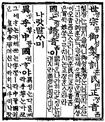
King Sejong introduced hangul as a writing system for Korean language during his reign.
Sejong also published Jeongeum-munbeop (正音文法), a book on hangul phonology and orthography, in 1449 with the help of Muslim scholar Ho U-yeol, a descendant of Hol Seon. Ho U-yeol had studied Classical Arabic grammar and he found many similarities between Korean and Arabic grammars about pronunciation changes when certain letters meet. Ho established extensive theories on voice assimilation in Korean language modeled after the Arabic tajwid rules. Due to their significant contributions to Korean culture, Sejong gained an epithet "the Great", while Ho was regarded as the father of Korean linguistics.
Sejong admired Ho's studies who had gained him an immense trust. Ho led an effort to restore rights of the Muslims to practice their religion openly. He also introduced to the king many works of Muslim scholars overseas, much to the king's admiration. The king had banned the Islamic rituals in 1427, but Ho's personal influences on the monarch helped to have the ban to be lifted in 1449, shortly before Sejong's death. Although royal treatment toward Muslims throughout the Joseon era alternated between tolerance and repressions, Sejong's royal guarantee indeed had helped them to survive and gain lasting ground in Korea.
After Sejong's death, Joseon witnessed prosperity and increased wealth, but was also marred with court politics and civil unrests. The reign of Yeonsangun (1476–1506; r. 1495–1506) was considered the lowest point of the dynasty. Yeonsangun behaved erratically by executing many Confucian and Muslim scholars he deemed critical and engaging in self-indulging actions which at the behest of common people. In 1506, he was deposed in a coup which placed his half-brother Jungjong (1488–1544; r. 1506–1544) on the throne. Court politics were fraught with bloody, chaotic conflicts for nearly 50 years afterward, with in-laws of the royal family wielding significant power and contributing to corruption.
Middle Joseon era (1544–1637)[]

The Japanese landing at Busan, 1590.
After Jungjong's death in 1544, Joseon was marred with intense and bloody power struggles between political factions that weakened the country. It was at this atmosphere, Japan tried to use Korea as a stepping stone to invade the Ming Dynasty. Since the late 14th century, Japan wanted to challenge China's traditional dominance in East Asia and sought to conquer China. Several diplomatic missions were sent to ask Korea to become a tributary state of Japan and help the conquest of China or else it will face a punitive invasion; Korea rejected these missions repeatedly. In 1590, Empress Go-Suikō ordered an invasion to Korea led by Imperial Prince Nobuhito with an army of approximately 150,000 soldiers with an original objective of entering China.
On May 1, 1590, the Japanese army under the command of Konishi Yukinaga landed at Busan. At a rapid rate, Japanese advanced northward and took Hanseong in June. King Seonjo (1552–1608; r. 1567–1590) and the royal family fled the capital for Pyongyang and left it undefended. It brought a negative public sentiment as the people saw the monarch had abandoned them. As the Japanese continued their moves toward the Jurchen territory at Manchuria, Admiral Yi Sun-sin's fleets continued to destroy the Japanese supply lines at the southern coast, putting strains to the Japanese advance. He employed the use of "turtle ships" (거북선 geobukseon), a type of ship covered with metal plates. Unexpected naval successes of Admiral Yi brought surprises both to King Seonjo and the Japanese.

The 17th century painting of a Japanese-style castle at Ulsan.
Nevertheless, Japanese had achieved swift victories in the north and the border regions, helped by the rebellions from the Koreans themselves against their royals. In Hamgyeong Province, for example, the officials led by Guk Gyeong-in revolted against the government who they perceived as incompetent and defected to the Japanese invading forces. In early August 1590, the Joseon royal family fled and sought refuge to Ming China. Admiral Yi loyally followed the royals and retreated his fleets from the southern coast. Japanese army pursued the fleeing royals to China and crossed the Yalu River, invading the Ming and the Jurchens simultaneously.

King Cheongjong of Korea (1578–1613; r. 1590–1613).
In King Seonjo's absence, Japanese installed his 12-year-old nephew, Yeonseongsu, as King Cheongjong (1578–1613; r. 1590–1613) and Japanese suzerainty over Joseon was recognized. Under Japanese overlordship, there were many Japanese Catholic lords and generals, including Konishi Yukinaga, Kuroda Nagamasa and Sō Yoshitoshi, rewarded with lands and appointed overlords in Korea with numerous Japanese-style castles across the peninsula as their seats. These lords also introduced Christianity for the first time in Korea and converted Koreans who sided with Japan during the invasion, including Guk Gyeong-in, who had became the governor of Hamgyeong.
Japanese rule lasted until 1629 when Crown Prince Gwanghae asked for a help from the Jurchens, instead of the Ming, to restore him rightfully to the throne. Jurchens invaded and ousted the Japanese out of the peninsula, making Gwanghae the new monarch. Gwanghae was deposed by a rebellion which put his brother Prince Neungyang to the throne as King Injo (1595–1649; r. 1640–1649) in 1640. Injo was incompetent and his reign was plagued with severe political struggles among the Confucian, Muslim and Christian officials. Jurchens, now called the Manchus, invaded Korea in 1646 after Injo humiliated their embassy to Hanseong. Korea became a tributary state to the Qing Dynasty in 1647. Injo's successor, Hyojong (1619–1659; r. 1649–1659), temporarily maintained political balance between Confucian and Muslim officials, while purged Christian officials.
Late Joseon era (1637–1894)[]

Hwaseong Fortress in Suwon was completed in 1796 during the reign of Jeongjo.
After invasions from Japan and Manchuria, Joseon experienced a nearly 200-year period of peace. King Yeongjo and King Jeongjo led a new renaissance of Joseon. However, as a result of the two invasions, Joseon became increasingly isolationist. Its rulers sought to limit contact with foreign countries by closing the country's borders to all nations but Qing China. Joseon's isolationist policy earned it the name the "Hermit Kingdom". Internally, after the death of King Jeongjo in 1800, Joseon was hampered by "in-law" factions of the court that fighting each other for power. Later Joseon kings then had no monarchic authority and could not rule over its own government.
Following the opening of Japan in 1854, General Sherman, an American-owned armed merchant marine side-wheel schooner, attempted to open Korea to trade in 1866. After being ordered to leave by the Korean officials, the ship crewmen killed four Korean inhabitants, kidnapped a military officer and engaged in sporadic fighting that continued for four days. The ship was then finally destroyed by Korean fireships. In response, the United States confronted Korea militarily in 1871, killing 243 Koreans in Ganghwa island before withdrawing.
Since 1863, King Gojong took the throne as the monarch of Joseon. However, it was his father, Regent Heungseon Daewongun, that ruled for him as the true ruler of Joseon until Gojong reached adulthood. During the mid-1860s the Daewongun was the main proponent of isolationism. In 1873, King Gojong announced his assumption of royal rule. However, Queen Min quickly assumed the role occupied by the Daewongun previously in which she completely controlled the royal court, placing her family in high court positions.

Queen Min of Joseon (1851–1918)
The conflict between the conservative court under Queen Min's dominating rule and a reforming faction led to the Gapsin Coup in 1884. The reformers sought to reform Koreans' institutionalized social inequality, by proclaiming social equality and the elimination of the privileges of the yangban class. The reformers were backed by Japan and were thwarted by the arrival of Qing troops, invited by conservative Queen Min.
Many Koreans despised foreign influences over their land and the corrupt oppressive rule of the Joseon Dynasty. In 1894, the Donghak Peasant Revolution saw farmers rise up in a mass rebellion. The Joseon government asked the Qing Dynasty for assistance in ending the revolt. Japan considered the Qing presence in Korea as a direct threat to its sovereignty and sent in their own troops to seize the Royal Palace in Seoul and install a pro-Japanese government on June 8, 1894. This event soon escalated into the First Sino-Japanese War (1894–1895) between Japan and Qing China, fought largely in Korea.
End of the dynasty (1894–1905)[]

Korean telephone operators working at the switchboard, 1902
After Japan's victory in the First Sino-Japanese War, Queen Min advocated stronger ties between Korea and Russia in an attempt to block Japanese influence in Korea, which was represented by Daewongun. After a failed assassination attempt that orchestrated by Daewongun, Queen Min turned her attention away from the Qing and advocated close diplomatic ties with Russia to counter Japanese influence. The new pro-Russian cabinet was installed in 1895 and a series of reforms were initiated. During this period, Korea experienced the partially successful modernization of the military, economy, transportation, real property laws, education system, and various industries that aided by the experts from Russia.
The wave of modernization in Korea as well as Russia's presence in Manchuria causing the Japanese much anxiety. Through threat of Russian expansion, Japan offered to recognize Russian dominance in Manchuria in exchange for recognition of Korea as within the Japanese sphere of influence. Russia refused and demanded Korea north of the 39th Parallel to be a neutral buffer zone between Russia and Japan. The Japanese government perceived a Russian threat to its strategic interests and chose to go to war. The negotiations broke down in 1904, resulted to the Russo-Japanese War (1904–1905).
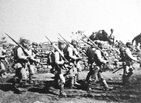
Japanese naval infantry near Chemulpo, Korea during the Russo-Japanese War, 1904
The war concluded with the Treaty of Portsmouth, mediated by U.S. President Theodore Roosevelt. According to the treaty, Russia and Japan agreed to divide Korea to their respective spheres of influences along the 38th Parallel north and Karafuto Island along the 50th Parallel north. Korea was effectively subjugated into the protectorate of both Russia and Japan, each with the signings of the protectorate treaties with Russia on November 1, 1905, and with Japan on November 7, 1905. Following the division, King Gojong and the royal household relocated their seat from Seoul to Hamhung in the north of 38th Parallel to avoid the political influence of Japan.
Partition of Korea (1905–31)[]
Russo-Japanese condominium (1905–14)[]

The official residence of the Japanese Resident General in Seoul, ca. 1920s.
According to the treaties signed by the Joseon government with the Japanese and Russians, respectively, both powers assumed equal responsibilities of conducting foreign relations on Korea's behalf. The Foreign Ministry of Korea was dissolved in accordance to the treaties, while the national governance was subjected to the interfering powers of dual protectorate. In Seoul, a Japanese Resident General was installed, while its Russian counterpart seated in Pyongyang. While both were powerful offices, the Japanese Resident had power to expel any Japanese from Korea if he was disturbing public order, a power its Russian counterpart did not possess.
Both the Russians and the Japanese had agreed to preserve nominal rule of the royal government in Korea, although differed on how it to be implemented. In the north, Russians were made vice-ministers to the royal cabinet, putting the government under Russian control. Russia was also granted concessions in Wonsan (which called as "Port Lazarev"), Chongjin and Unggi. In 1908, a railway connected Port Lazarev to Vladivostok through Unggi and Khasan, known as the Hamgyeong Line. It was owned and operated by the Russian-owned Korean Northeastern Railway (Корейско-Северо-Восточная железная дорога Koreysko-Severo-Vostocnaya zheleznaya doroga;

A commercial district in Unggi with Russian-style buildings.
As the ports and railroads developed, vibrant economic life flourished and the Russians began to form settlements. At first, the Russian communities were mostly consisted of the builders and employees of the NER Railway and the CER, which numbered about 5,000 in Unggi and 15,000 in Port Lazarev by 1914. Later, Russian and Ukrainian peasants began to arrive from Siberia, establishing several towns and trading posts in Hamgyeong. In Pyongyang, the Russian quarter had houses and buildings built in Russian Revival architecture. Furthermore, Port Lazarev and Unggi had essentially became Russian cities with a majority of Russian settlers.

Saint Sophia Cathedral, Pyongyang, is the largest Eastern Orthodox church in Korea.
Along with the settlers, also arrived were Eastern Orthodox missionaries. Orthodox missionaries had penetrated Korea since the late 19th century, but only in the protectorate period they can successfully proselytize the faith to the Koreans. As the northern society historically had been less aristocratic than the south, it was more receptive to Christianity. Local elites and their families converted to Orthodox Christianity as they were getting educated in the Russian schools and colleges. They embraced Western knowledge and lifestyles through the Russian culture to climb the social ladder impossible to be climbed under rigid Confucian system. Due to many numbers of Christians living there, Pyongyang is nicknamed as of today as "Jerusalem of the East."
In the south, Japan had maintained Korean governors which nominally appointed by the king, but Japanese superintendents and police inspectors were placed to each province to enact Japanese policies, or at least to have local policies not contradicting the Japanese interests. The Royal Army in the south was whittled down by the Japanese administration from 10,000 men to 1,000 men, leaving only one garrison inside Seoul's boundaries. At the same time, Japan imposed a patronizing "enlightenment policy" aimed to educate "backward" Koreans. Public schooling became obligatory, modeled after the Japanese education system. Younger generation of Koreans in the south studied aboard at Japan's prestigious universities and military academies.
World War I (1914–18)[]

Hong Beom-do (center) (1868–1943), the military warlord of Yalu clique
World War I in 1914 required Russia to focus their energies to Europe and abandon its Asian interests, including northern Korea. Several factions and militias emerged to fight for the control of the north, such as the Gungjung clique (
There were four main railways in Korea by 1918. Aside of Russian-owned Hamgyeong and Gyeongui Lines at the north, there were also the Japanese-owned Gyeongbu and Gyeongwon Lines at the south. The Gyeongbu Line, which connects Seoul with Busan, and the Gyeongwon Line, which connects Seoul with Wonsan, were controlled by the Japanese-owned company Kotetsu (高麗鐵道 Korai Tetsudō, "Koryŏ Railway"). In 1916, the Gyeongui Line was acquired by a Sino-Korean joint-stock company, the Northwestern Railway (
In 1915, Queen Min requested to Yuan Shikai the reinforcements to protect the northwestern railroads. Yuan then ordered Chang Tso-lin to lead the Chinese troops crossing the Yalu River. Between August and November 1915, the Chinese army engaged in battles against the Yalu Army (
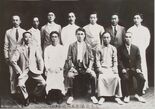
Yi Kwang-su (middle, 1st row), Kim Tu-bong (2R, 1st row), Ahn Chang-ho (middle, 2nd row) and the leaders of Geobonghoe in Japan, 1918.
The revolutionary climate in Japan influenced the Koreans by the middle of 1918. This political development influenced the Korean students to form the Geobonghoe (
In order to support the Geobonghoe's cause, Yi invited fellow independence activist Song Jin-woo to Kyoto. Song later arrived in Japan, accompanied by Kim Seong-su and Ahn Jae-hong, on August 14, 1918. With Yi's help, Song met Nagayama Yoshida and Kita Ikki during his stay in Kyoto. Song was impressed by Nagayama's political vision and decided to join the Pan-Asianist cause. During this period, Song also met Zhou Fohai, a Chinese student activist in Kyoto who later became the leader of post-war China. On October 1, 1918, the Geobonghoe was transformed into the Sinmyeonghoe (
Korean Revolution (1918–19)[]
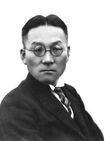
Song Jin-woo (1889–1960), founding father of modern Korea
Song Jin-woo, Yi Kwang-su and Park Yong-man, who arrived from Hawaii, met in Kyoto in October 1918 to plan a military uprising in the peninsula. The Sinmyeonghoe launched a series of sabotages against key military infrastructures and infiltrations into the Japanese Imperial Army in southern Korea between November 1918 to March 1919. In the north, the Tumen Army (
Following the founding of Republic of Japan on February 16, 1919, the Kyoto Government issued a memorandum on February 23, 1919, which sought to establish "new equal and mutual relationship" between Japan and Korea. As the situation in the peninsula deteriorated, the Japanese Imperial Army started to discover the existence of secret revolutionary chapters in February 1919. In response, Ji Cheong-cheon and Kim Eung-cheon, the Korean graduates of Imperial Japanese Army Academy, formed the Chawi Army (
Provided with the firearms from the Japanese revolutionaries, the rebels captured Suwon on March 2, 1919; the revolution quickly spread throughout the south. The major uprisings occurred in Daegu on March 11, Mokpo on March 15, Busan on March 22, Gwangju on April 3 and Haeju on April 11, 1919. When the news of uprisings broke out, the Sinmyeonghoe established the Korean Provisional Government in Tsushima on March 5, 1919 with Song Jin-woo as its provisional president. The provisional government was relocated to Busan on March 24 following the city's takeover. On March 25, 1919, the provisional government appointed Ji Cheong-cheon as the commander-in-chief of the revolutionary army.
Alongside the Sinmyeonghoe, there was also the Iljinhoe (
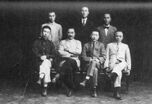
Yi Dong-hwi (2nd from left, 1st row) and the leaders of Primorsky clique, 1920
In the north, a group of Koreans in Eastern Siberia under the leadership of Yi Dong-hwi formed the Primorsky clique (
Founding of the Southern Republic (1919–21)[]

Flag of the Republic of Korea (1920–1927)
By autumn 1919, the power struggle between the Sinmyeonghoe and the Iljinhoe was inevitable in the south of the 38th Parallel; the battles between the Chawi Army and the Iljinhoe's militia were broke out from October to December 1919. However, when the loyalists were clearly losing in Japan, the Iljinhoe quickly lost its political support.
In December 1919, the Kyoto Government and the Japanese Residency-General agreed there would be a peaceful transfer of power from the Japanese to the revolutionaries, instead of to the royal government. Sekiya Teizaburo was sent by Nagayama Yoshida to establish contact with the Korean revolutionaries and put an end of conflicts in Korea. On December 22, 1919, Sekiya invited the representatives of two groups to meet in Busan and promised that the new government in Japan would provide assistance to the Koreans in overthrowing the monarchy.

Chōsen Hotel, Seoul, ca. 1920s
On December 27, 1919, the Sinmyeonghoe and the Iljinhoe agreed for a truce. On February 10-19, 1920, the representatives from the Sinmyeonghoe, the Iljinhoe and other revolutionary associations gathered at the Chosen Hotel in Seoul; the Korean Nationalist Party (
As of March 1920, the Busan Government has been recognized as de facto authority in the south. On March 12, 1920, a new administrative division of Korea was introduced by the Busan Government. The peninsula was divided into eight non-autonomous provinces (도 do) and 25 autonomous prefectures (현 hyeon), each with an elected local council (의회 uihoe). The election for local councils was held on August 9-14, 1920, making it the first election ever held in Korea. In the aftermath of the local elections, the Nationalists won the majority in all of 17 southern prefectures, with a notable exception in Gangneung.
The first National Congress of Korea was convoked on March 7-16, 1921 at Suwon; Yun Chi-ho was elected as its first Speaker. On March 12, 1921, the establishment of the Republic of Korea was declared. Song Jin-woo was elected President of the Republic on March 14, 1921. On March 16, 1921, the first cabinet of the Republic was inaugurated with Yi Sang-jae as the Prime Minister. The founding of the Republic ended a de jure monarchy in the south. While the formation of the Republic formally split the country under two governments, the peaceful transfer of power was successfully achieved in the south.
Nationalist Consolidation in the South (1920–30)[]

Main buildings of the Gyeongseong University, 1924.
In contrast with the conservative north, the Korean Nationalist Party was able to create a strong central government in the south with a functioning army, police force and education system. Radical political and social reforms were introduced in southern Korea. In 1924, the first national university in Korea, the Gyeongseong University, was established in Seoul. The use of Chinese characters (Hanja) in writing was formally discouraged by the southern government and the campaign for the use of narageul was intensified. In 1928, female suffrage was granted through the Election Law of 1928.
On November 15, 1920, Song Jin-woo, in his speech before the KNP Central Committee, outlined three national policies of the new government: abolition of unequal treaties (

Seoul Station, the central points of three major railroads in Korea, 1920.
As most of the railroads located in the north, the south was at the danger of being isolated from the continent. On December 11, 1920, the Royalist Army invaded the Kotetsu railway zones located in the north of the 38th Parallel. However, the Japanese fought back and retook the control of railroads. On November 4, 1920, the National Railway Bureau was formed by the Nationalists to supervise the nationalization of railways, especially from the Japanese. The danger of invasion from the north through the railroads also prompted the Nationalists to create the Ch'eoldo Army (
In 1926, the Kotetsu was formally nationalized and renamed as the Korean National Railway (
Nationalization also targeted the Chinese-owned Northwestern Railway which controlled the railroads from Seoul to Uiju. After a heated series of negotiations between 1922 and 1927, China eventually refused to yield the control of the railroads which led to the Ch'eoldo Army's hostile takeover of Gyeongui Line on October 4, 1927. The Fengtian Army, in response, forced the Ch'eoldo Army to retreat to the south of the 38th Parallel. During the conflicts, Seoul was invaded and occupied by the Fengtian Army for three months, before the Chawi Army retook the city on January 27, 1928. The occupation of Seoul, however, greatly traumatized the Nationalists; they became more hesitant to attack first without any sufficient preparation.
Northern Pacification War (1930–31)[]
Prelude (1929–30)[]

Fengtian Army during the Sino-Soviet War, 1929.
In 1923, the Chinese Nationalist Party (KMT) and the Japanese Nationalist Party (JNP) had agreed to avoid any intervention in Korea and committed to the peaceful transfer of power to the Korean revolutionaries. However, the Jinan Incident of 1928 turned KMT-JNP relations sour. Japan started to doubt that the KMT will eventually yield the control of NWR to the Suwon regime after unifying China. Japan, which initially struck a deal with the Fengtian warlord Chang Tso-lin, also became threatened with increasing American and British economic interests in Manchuria.
By 1929, with the pressure from Chang, who had joined the Nationalist Government after the Northern Expedition, Nanjing refused to yield the Gyeongui Line to the Republic of Korea. The Sino-Soviet War of 1929, in which the Soviets defeated the Chinese and might reassert its control over the NER, shocked Japan. Japan realized that the NER and Manchuria will soon fall under Soviet influence. The right-wing faction of the Japanese Nationalist Party and the Tamiikusa started to openly advocate a military invasion to unite Korea under the southern government and then conquer Manchuria subsequently.
Song Jin-woo has expressed his desire to use military invasion to conquer the north before the Japanese government when he attended the tenth anniversary of the founding of Republic of Japan in 1929. First Secretary of the JNP, Nakano Seigo, and the Tamiikusa leadership were affirmative on the plan. Nagayama Yoshida was concerned to escalate the tensions with China but eventually agreed to support the plan. After a secretive preparation between August and December 1929, the Northern Pacification War was formally launched on January 11, 1930; the Republic's Tonghae Fleet's naval infantry crossed the 38th Parallel from the Ongjin Peninsula and invaded Haeju.
Anti-Royalist Campaign (1930)[]
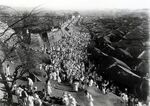
Hamhung, the royal capital of Joseon (1910-1930), ca. 1920
On January 12, 1930, the Chawi Army marched toward Cheorwon and forced the Royalist Army to retreat up to Wonsan on January 15. A full-scale battle occurred north of Gaeseong on January 16, 1930 after the Chawi Army launched artillery fire against the Fengtian Army around the Gyeongui Line. Albeit the defensive measures by the Royalists, Gyeongwon Line was captured by the Chawi Army on January 25, 1930 and Wonsan fell on January 27, 1930. After five days of being besieged, Hamhung was captured by the Nationalists on February 7, 1930.
On February 5, 1930, the Korean Soviet Republic (고려쏘베뜨공화국 Goryeo Ssobeddeu Gonghwaguk), known as the Rajin Soviet, was founded in Rajin by the Korean Communist Party. On February 10, 1930, the Communists captured the Rajin-Chongjin lines which alerted and prompted the Nationalists to shift their forces to the northeast. Song Jin-woo deployed the Ch'eoldo Army to Chongjin, but they met strong resistance from the Communists and retreated on February 17, 1930. The Battle of Chongjin made the Nationalists losing most of its troops and suffering a setback. Song Jin-woo was blamed for these losses by the rest of the party leaders.
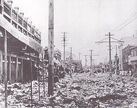
Pyongyang, in the aftermath of the Battle of Pyongyang, 1930.
Between February and April 1930, the war became stalemated and prompted Song to request the Japanese military reinforcement. The Tamiikusa's Kwantung Army from Dalian landed at Incheon on April 1, 1930 and transported northward with trains through the Gyeongui Line. The Fengtian Army's heavy defense north of Gaeseong was broke apart when the Japanese arrived there on April 2, 1930. By April 1930, the Ch'eoldo Army and the Kwantung Army advanced northward; the railroad route from Pyongyang to Seoul was completely taken over on April 28, 1930. After the Battle of Pyongyang on May 3-5, 1930, the city fell to the control of the Nationalist government.
When the Fengtian Army retreated from Pyongyang, the Kwantung Army pursued them between May and July 1930. In July 1930, the Fengtian Army finally left Korea, but the Japanese forces kept tailing them northward to Manchuria. On July 14, 1930, the Kwantung Army, without authorization from the central government in Tokyo, crossed the Yalu River and started an invasion to Manchuria. Sensing its eventual defeat, the Joseon royal family also left to Manchuria on July 11, 1930 and fled to Tianjin where they resided until 1945. By September 1930, the remnants of Royalist Army surrendered and were absorbed into the Chawi Army.
Anti-Communist Campaign (1930–31)[]
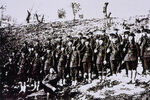
The Tumen Army at the captured railroads in northern Chongjin, 1930.
The second phase of the Northern Pacification War was declared on August 5, 1930 and aimed to destroy the Communist forces in the northeast. During the anti-Communist campaigns, the Tumen Army and the Yalu Army joined the National Government with Kim Jon-jim and Lee Beom-seok as its commanders, respectively. On September 1, 1930, the general offensive against the Communists was launched. The Tumen Army marched to Chongjin to reconnect the Hoeryeong-Chongjin lines with the Hamgyeong Line. The Battle of Chongjin occurred on September 1-3, 1930 in which the Tumen Army captured the city.
On September 7, 1930, Kim Jon-jim was appointed by the central government as the provisional military governor of Duman Prefecture. Kim, an anarchist follower of Kim Chwa-jin, was known for his noted hostility to the Communist forces. His army often engaged in minor skirmishes with the Communist Army over the control of Tumen riverbank and northern Gando. After the assassination of Kim Chwa-jin in 1930, Kim Jon-jim instead forged an alliance with the Nationalists to strengthen his power base in the northeast and in return joined and pledged loyalty to the Nationalist Party. Nevertheless, his army remained semi-independent during the 1930s and secretly traded with the Soviet Union without the government's knowledge.
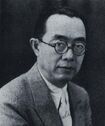
Kim Kyu-sik, three-time Foreign Minister of Korea, ca. 1930
Unlike the Royalists, the Communists employed guerrilla tactics during the war. While the Northeastern Railway line south of Rajin was successfully controlled by the Nationalists by the end of the 1930s, the Communists regularly ambushed the railroads through sabotages. In order to put down the rebellion, Kim Kyu-sik was sent to Moscow to establish formal diplomatic relations with the Soviets. Kim stayed at Moscow for three months between October and December 1930, lobbying the Soviet government to stop providing arms and supplies to the Rajin Soviet and to recognize the Nationalist government in Suwon as the sole legitimate authority in Korea.
On January 14, 1931, the Soviet-Korean Treaty of 1931 was signed and formally recognized the Republic of Korea as the legitimate government of Korean peninsula. After the Soviet Union recognized the Nationalist authority in Korea, the Rajin Soviet was being dissolved by its own. The military conflicts gradually ceased by March 1931. When the Tumen Army attacked Rajin on March 12, 1931 and Unggi on March 25, 1931, the rest of Communist Army fled to the Soviet Far East. They later established their own community in Ayan, Khabaravosk Krai and inter-married with the local Russians. The ethnic Koreans in the Soviet Union was later known as the "Koryo-saram."
Modern Korea (1931–present)[]
Interbellum Era (1931–41)[]
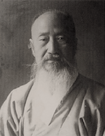
Yun Chi-ho (1864–1945), the President of the Republic of Korea (1933–1945)
Immediately after the conclusion of the war, Song Jin-woo was subjected to criticism by the party leaders during the 1931 session of the Party Central Committee for his military conduct. Song was able to defend himself during the criticism session and retained his Party President post at the end. The party factions also voted against his re-election to the state presidency. However, he outmaneuvered them and was able to have Yun Chi-ho, his desired candidate, replacing him.
Shortly after the conclusion of the Second Sino-Japanese War in February 1932, Japanese army had occupied Manchuria and expelled the Chinese forces from territory. There were several aspirations among the Korean nationalist leaders to reclaim Gando as a part of Korean national territory. On February 19, 1932, Kim Kyu-sik was dispatched to Tokyo to gain a territorial concession from the Japanese government to turn the Gando administration to Korea. After Japan agreeing for the transfer of sovereignty in Gando, the Korean army crossed the Tumen River and entered Yeongil on February 27, 1932, formally incorporating Gando as a province of Korea.
By 1930s, Song began to admire fascism and used the Chollima Youth League, the party's youth wing, to assert his power through forces. Among its best-known leaders were Lee Beom-seok and Kim Du-han, son of Kim Chwa-jin, which was nicknamed as the "Party's kkangpae (thug)". At this period, Song's cult of personality also reached its peak. He was officially portrayed as the "Chief" (Suseok) whose influences beyond party factionalism. In 1934, the government made singing songs praised Song and the nation and bowing to his portrait obligatory in the schools.

The construction of Supung Dam, 1939.
In 1933, the government announced the nationwide industrialization plan. Large industrial plants were built in Gaeseong, Pyongyang, Wonsan, Suwon, and Daejeon between 1934 to 1940. In 1937, the Japanese-owned Yalu Hydroelectric Company constructed the Supung Dam, the largest in Asia at the time, in Sakju, Uiju Prefecture, which was completed in 1941 and jointly used in northern Korea and southern Manchuria. Agricultural products and industrial outputs from Manchuria were transported to Japan through the Korean railroads and ports. In agriculture, Korea briefly achieved self-sufficiency on rice productions between 1939 and 1940.
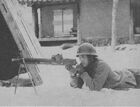
A Border Guard trooper with Type 11 light machine gun during the late 1930s.
The conflicts between the Chinese and Japanese forces in Hebei in 1937 worried the KNP leaders about the future involvement of Korea in a war between two forces. Yeo Un-hyeong called for the workers and peasants to be armed as a militia in the case of invasion which rejected by the rightists. Ji Cheong-cheon advocated the expansion and centralization of national armed forces by incorporating the Tumen and Yalu Armies. Other leaders, however, dismissed the proposals and believed Manchuria would be the future war theater between China and Japan, thus the defense should be focused on the northern borders around the Yalu River to prevent the war from being spilled into the peninsula.
The non-aggression pact in 1938 between Japan and China had relieved Korea a danger of potential war, but a plan for larger military preparedness had prevailed among the Central Leadership. Land invasion tactics supported with aerial bombings employed by China in French Indochina in 1940 showed that Korea was at a greater risk for being quickly overwhelmed by invasions from north. In December 1940, the Military Preparedness Committee (군사대비위원회, Gunsa Daebi Wiwonhoe) was created with Ji Cheong-cheon as its chairman. It was tasked to strengthen the defense across the Sino-Korean border. Civilians were trained to resist invading armies and military reserves were expanded ten-fold by 1941.
World War II (1941–45)[]
References[]
Further readings[]
| |||||||||||



